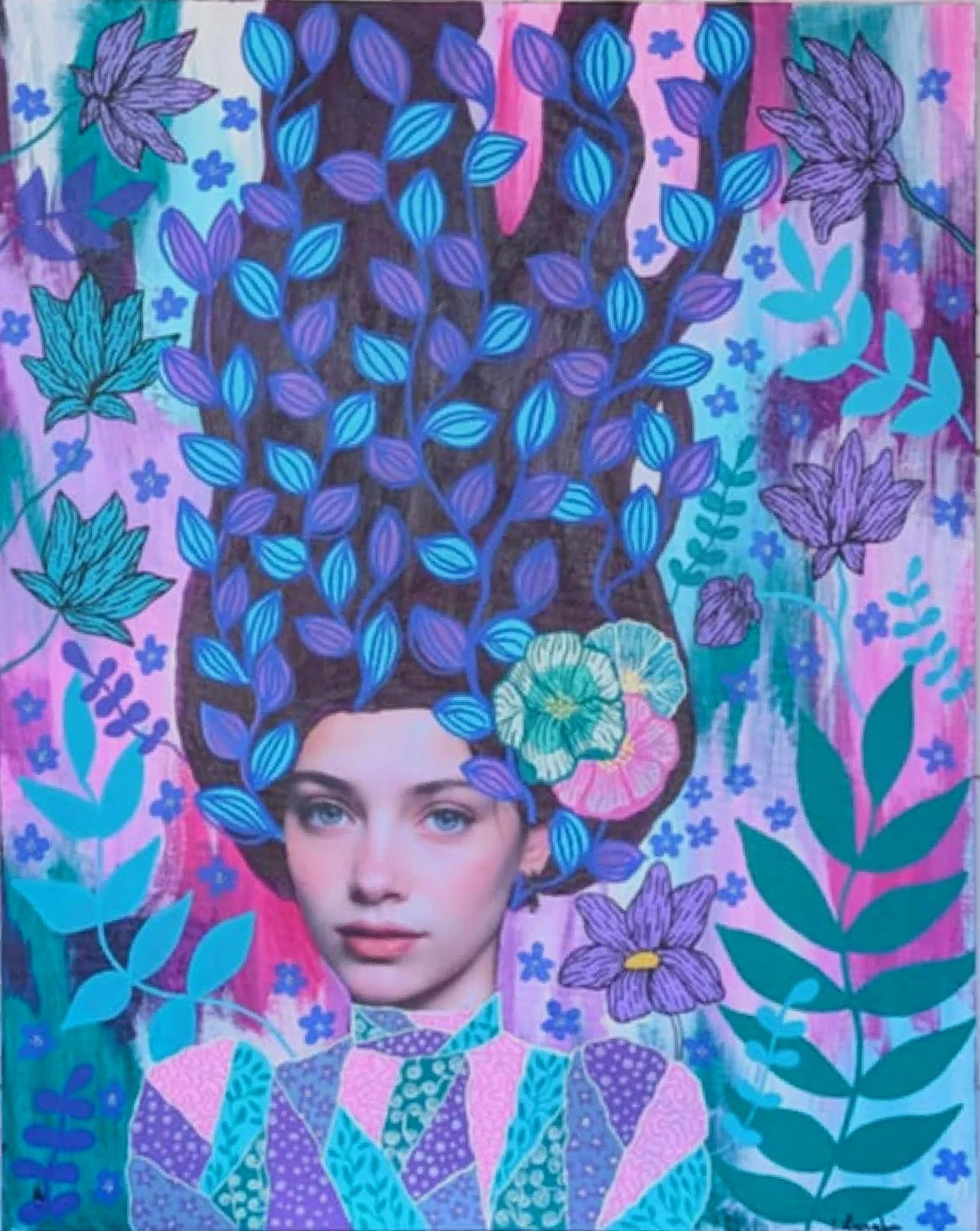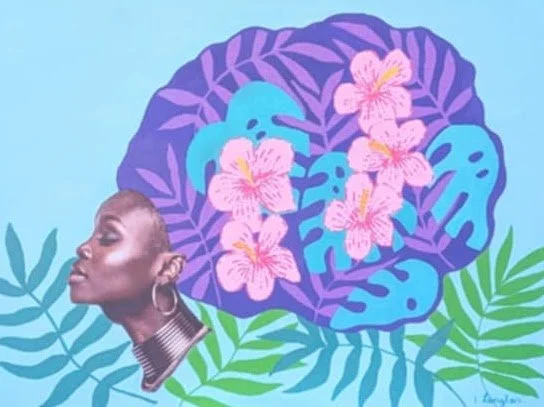Interview
Isabelle Langlois
Born in Montreal in 1979, Isabelle Langlois lives in St-Jean-sur-Richelieu, Canada. With a degree in visual arts and a specialized educator, Isabelle splits her time between her passion for image and her passion for humanity, for being. As an counselor in domestic violence, Isabelle is fascinated by the strength and resilience of the women she meets in shelters, and she attempts to pay tribute to them through her art. Witness to both the worst horrors and the greatest beauties, Isabelle tells their pain but also their victories and joys. Her paintings speak of beauty, resilience, strength, hope, and reconstruction.
In terms of pictorial art, Isabelle Langlois is inspired by urban art, Art Nouveau, surrealist pop, zentangle, graphic design, and pop art. All these fused influences create a unique style. Portraits (photo collages), lines, and patterns are superimposed. Isabelle enjoys working with paint markers regularly used by urban artists, which allows her to develop a graphic rendering more akin to drawing than to gestural painting. She integrates photo collage, stickers, paper, and small stones.
What is your background and how did you start your journey in the art world?
“I have been painting since the age of nine. My mother, who was impressed by my drawings, signed me up for an oil painting class. It is truly a blessing to be encouraged in your passions. Then, I obtained a college diploma in visual arts and a Bachelor’s degree in visual and media arts at university. After that, I continued my journey on my own, and over the years, I developed my current style.”
What inspires you?
“I love images; I look at several every day. Sometimes, I draw inspiration from their composition, content, subject, or colors. For me, creativity is, among other things, the ability to transform all the inspirations around us into a unique and personal image. I draw a lot of inspiration from urban art, Art Nouveau, Zentangle, graphic design, and pop art. I have a passion for patterns that I incorporate into my paintings, which is why I am interested in Zentangle, which uses drawing patterns as a means of active meditation. The beauty of women, their strength, and their resilience is a theme that inspires me greatly and underpins my art.”
What themes do you pursue? Is there an underlying message in your work?
“In addition to being an artist, I work as a domestic violence conselor in a shelter. I try to represent in my paintings the beauty, strength, and resilience of these women who, despite their ongoing psychological destruction, continue to move forward in life while keeping hope for a better future. It’s impressive. In my art, I depict their physical and inner beauty using aesthetic elements and vibrant colors. I try to honor them by creating beautiful paintings worthy of their reconstruction process. The reconstruction process is also a theme I attempt to represent in my work because I find it magnificent, the strength required to use a difficult moment or trauma as a springboard to rebuild oneself and become more fulfilled than before. Just like the caterpillar that decomposes to transform back into a beautiful butterfly, freer and more fulfilled than ever. It’s very inspiring.”
How would you describe your work?
“My work is the visual representation that I have of the strength, resilience, and beauty of women. I represent, among other things, the process of reconstruction using photographic portrait collages of women, juxtaposed with different sections that come together to give the impression of a reassembled object. I also try to create images of great beauty not for superficial purposes but to represent the beauty of rebirth and resilience. To achieve this, I use beautiful bright colors and elements such as flowers and leaves that truly represent beauty and flourishing. I integrate patterns that express the impact of consistency and repetition in a reconstruction process. The addition of the photographic portrait associated with the painted elements represents well, I think, the process of reconstruction, which means starting with existing facets of ourselves, our qualities, our strengths, and our soul, combined with new elements that help us grow and elevate us.”
Which artists influence you most?
“Several artists influence me as much from past artists as from current artists. Among historical artists, Alphonse Mucha and Gustav Klimt inspire me, among others, because they portray women in a magnificent way. There are also some illustrators from the 1960s like Nicolas Devil, Bonnie Mac Lean, and Wes Wilson who designed beautiful posters with an Art Nouveau style. Artists from the Pop Art movement like Roy Lichtenstein and Evelyne Axell have also greatly influenced me. In contemporary artists, urban artists like Shepard Fairey and Hush impress me a lot. Among other artists, Audrey Kawasaki, Tahlia Stanton, Shahul Hamed, Antoine Stevens, Kildren, and Olly Howe inspire me immensely because they represent women in a unique, beautiful, and original way.”
“For me, creativity is, among other things, the ability to transform all the inspirations around us into a unique and personal image.”
What is your creative process like?
“Usually, I start with a visual idea of several elements that I want to combine together, however, the image develops gradually. Especially regarding the colors and integrated patterns. What I find interesting is that I feel there is a moment during the creative process when the work takes on a life of its own and strays from the original concept, which sometimes strangely results in something very close to my subconscious. I sometimes realize that I am reflecting not only the resilience of women but also my own resilience through my works.”
What is an artist’s role in society and how do you see that evolving?
“I believe that the role of an artist can take different forms, among others to denounce injustices or to evoke emotions in people. For my part, I like the idea of sharing my creative vision of the world with beautiful visual images that most people cannot imagine. I want to bring beauty and hope into people's lives. I have the ability to bring out beauty in people, and I try to do the same in my art. I also like to represent my vision of personal growth. I believe that art will take an increasingly important place in our lives because with technology and social media, it is now easier to discover artists from all over the world and at the same time present our work to the entire world.”
Instagram: @isabellelanglois79
Brush Bio: www.brush.bio/isabellelanglois














